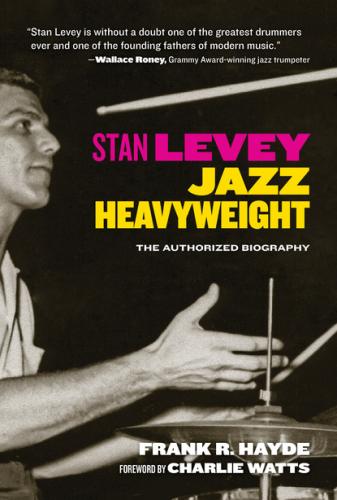Copyright ©2016 by Angela Levey and Bob Levey
All rights reserved.
This book may not be reproduced in whole or in part or in any form or format without the written permission of the publisher.
Published by:
|
|
Santa Monica Press LLC P.O. Box 850 Solana Beach, CA 92075 1-800-784-9553 |
Santa Monica Press books are available at special quantity discounts when purchased in bulk by corporations, organizations, or groups. Please call our Special Sales department at 1-800-784-9553.
This book is intended to provide general information. The publisher, author, distributor, and copyright owner are not engaged in rendering professional advice or services. The publisher, author, distributor, and copyright owner are not liable or responsible to any person or group with respect to any loss, illness, or injury caused or alleged to be caused by the information found in this book.
ISBN-13 978-1-59580-810-3
Library of Congress Cataloging-in-Publication Data
Names: Hayde, Frank R.
Title: Stan Levey: jazz heavyweight / by Frank R. Hayde.
Description: Solana Beach, California: Santa Monica Press, [2016] | Includes bibliographical references and index.
Identifiers: LCCN 2015041922
Subjects: LCSH: Levey, Stan. | Jazz musicians--United States--Biography. |
Drummers (Musicians)--United States--Biography.
Classification: LCC ML419.L447 H39 2016 | DDC 786.9/165092—dc23
LC record available at http://lccn.loc.gov/2015041922
Cover and interior design and production by Future Studio
All photos courtesy of the Stan Levey Family collection, with the exception of page xiii, upper, © Ross Burdick/CTSIMAGES.
CONTENTS
INTRODUCTION BY CHARLIE WATTS OF THE ROLLING STONES
CHAPTER 1: NATURAL RHYTHM
CHAPTER 2: THE FIGHT RACKET
CHAPTER 3: FIFTY-SECOND STREET
CHAPTER 4: THE BIRD FLIES IN
CHAPTER 5: BEBOP
CHAPTER 6: CALIFORNIA
CHAPTER 7: PRISON AND REDEMPTION
CHAPTER 8: ARTISTRY IN RHYTHM
CHAPTER 9: BIRD LIVES!
CHAPTER 10: WEST COAST COOL
CHAPTER 11: THE BIG TIME
CHAPTER 12: HOLLYWOOD STUDIOS
CHAPTER 13: LIFE AFTER MUSIC
RECOMMENDED LISTENING
EPILOGUE
ACKNOWLEDGMENTS
SOURCES
INDEX
NOTE TO THE READER
This book alternates between the author’s third person narrative and Stan Levey’s own words, which appear in this font and feature a bold, drumstick line along the left side of the quote.
Stan’s own words come from audio recordings provided by his family, and other interviews and sources listed herein. Most of Stan’s quotes are verbatim, but I have linked sentences he spoke on the same subject from different sources. Direct quotes he spoke to family members, who relayed them to me, are sometimes attributed directly to Stan instead of through the person he spoke them to. In some cases, I have taken artistic license in how Stan expressed something if it served to eliminate confusion, clarify the context of the subject matter, correct errors in chronology, etc.
by CHARLIE WATTS of the Rolling Stones
The first time I heard of Stan Levey was when I was about fifteen years old and I was collecting all the Charlie Parker stuff. The band that Dizzy Gillespie took to Los Angeles in about 1946—an amazing band—Stan was in that band. Stan was one of the original bebop players from this very innovative period when they completely changed playing. To hold down the drum chair with Dizzy and Parker is something else.
Stan could hold a tempo that was unbelievable. It’s very difficult to play fast and keep on top of it. Really difficult. It takes a whole sort of athleticism. You have to jump—be on top of every beat—hold a tempo on top of a tempo. Stan was a master of that. The other thing with Stan is he was a very good boxer. That’s what I think kept him in great shape for that sort of thing.
He moved to Hollywood and was playing what’s called West Coast jazz. Those are my favorite records of Stan, that stuff from Contemporary Records, which had a yellow record label, and Bethlehem Records. For me as a young sixteen- or eighteen-year-old in London, buying records and trying to learn how to play, Stan was synonymous with the West Coast school. To see them all playing live, these jazz musicians in the 1950s, must have been unbelievably fantastic. One of the bands Stan played in that gave him terrific notoriety was the Stan Kenton band.
I think this is a piece of jazz history that’s very important to document. Stan is a link. His life is an amazing story and he was a lovely man. I was totally in awe of meeting him and the legacy that he carries.
No toys in young Stan Levey’s room—only a bed, a closet, a little bureau, and a big, lonely boy. The only sound was his clock: the wind-up kind with crisp precision time, loud and percussive.
I could hear it all the way from the bathroom.
Sometimes he’d save a picture of a toy from a newspaper or magazine—Lincoln Logs or an erector set. The pictures were a sad substitute, and when their novelty wore off, it was back to the clock.
Stan’s father was a boxing manager and part owner of a used car lot. As a fight manager in 1930s and ’40s Philadelphia, he occupied a low-level position in the national crime syndicate. Stan’s mother Esther, known to all as Essie, was a comely and intelligent woman with domestic skills, style, and musical talent, but she was an alcoholic.
It didn’t take much to affect her. A drink or two and pow! I She was slurring her words and staggering.
Though he was born Adolph Stan Levey, Stan’s parents always called him by his middle name. He didn’t have any brothers or sisters. When his parents fought and screamed and drank,
